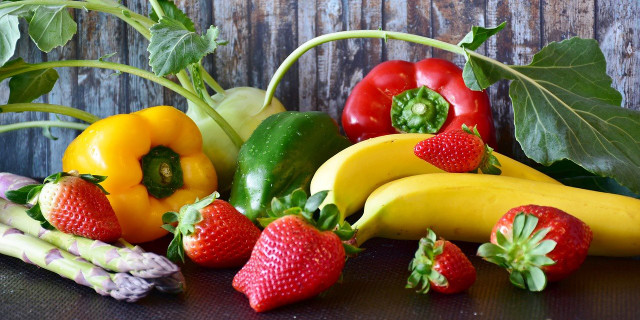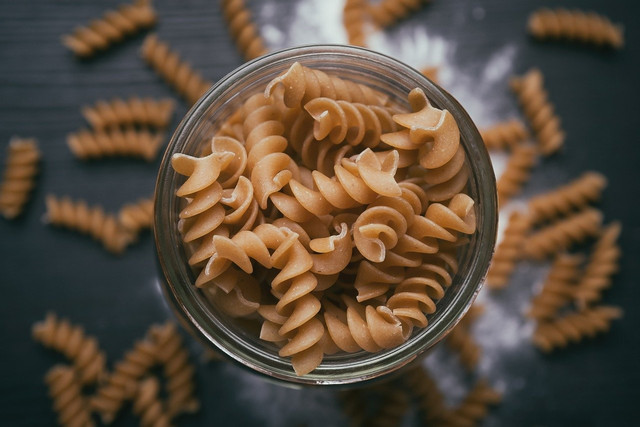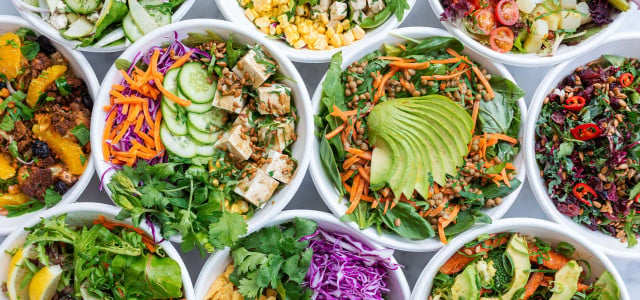Eating balanced meals is essential for a healthy lifestyle. In most cases, you can eat healthily without food supplements or strict diets.
There is a lot of talk about eating a balanced meal when it comes to a sustainable and healthy lifestyle. But what does this actually mean? You can use our ten rules as a guideline for putting together a balanced menu.
1. Mindfulness is the First Step to a Balanced Meal

Before we get to what we should be eating, let’s talk about how we should be eating.
- If you take time for your meals and eat slowly and mindfully, you will enjoy your food more. Just concentrating on chewing enough will help.
- Slowing down will also prevent you from overeating: You don’t start to feel full until 10 to 15 minutes after you start eating.
- You should try to avoid distracting external influences when eating: Switch off your TV and your smartphone!
Being mindful of what we eat also means not wasting food. Here are 10 simple tips for reducing food waste.
2. A Balanced Menu is a Varied Menu



A healthy diet makes use of the entire range of foods because no single foodstuff contains all the necessary nutrients. A balanced meal should be colorful and varied.
- Vegetables, fruit, cereals, pulses, oils, seeds, and nuts – make sure each meal contains a balanced mixture of food groups. Also, try to vary as much as possible within the groups – there are so many vegetables to choose from, for example!
- By following a seasonal calendar (the USDA has a really clear one), this variety is almost guaranteed, as regional availability changes with the seasons. A seasonal and regional menu plan is not only good for you and your health but also far more sustainable.
3. Get Your Five a Day: A Balanced Meal Should Always Include Fruit and Vegetables



The ‘five a day’ rule is a useful guideline. It says that you should eat three portions of vegetables (400 g or 15 oz) and two portions of fruit (250 g or about 9 oz) per day – or just think of a portion as roughly a handful. Fresh fruit and vegetables, accordingly, form the basic foundations of a balanced menu.
You should try to include some in every balanced meal – for example, by chopping fresh apples or bananas into your muesli, eating a salad for lunch, or enjoying your pasta with fresh tomatoes, spinach, or carrots.
Nuts, oily seeds, and dried fruit can also be part of your five-a-day. Due to their higher calorific content, the portion size here is about 25 g or 1 oz. Even a smoothie or freshly squeezed juice can occasionally replace a portion of fruit – but not too often because these usually contain a lot of hidden sugar in the form of fructose.
4. Minimize Sugar and Salt



Sugar is just empty calories, and also increases the risk of tooth decay. Increased sugar consumption is also said to be indirectly related to an increased risk of diabetes.
- However, the problem is rarely the sugar we add to our coffee or food, but the hidden sugar in processed foods and beverages.
- Examples of sugar traps include fruit yogurts, juice, or breakfast cereals. And even sauces, dressings, and convenience food like pizza often contain surprising amounts of sugar. Avoid industrially processed foods altogether and you’ll have complete control over how much sugar is in your food!
Too much salt is also dangerous for the body: Too much sodium can increase blood pressure and thus also the risk of cardiovascular diseases.
- We often consume much more salt than we realize, like sugar, in processed foods. Fast food, meat products, and cheeses are often particularly salty. But there’s a lot of salt in bread and most processed foodstuffs too!
- Even when cooking at home, we often put more salt in our food than necessary. Tip: For a balanced menu, try your food just with herbs and seasonings before you add salt.
- You can reduce the salt content in your food step by step. In the beginning, dishes with less salt may taste a little dull. But with time, your taste buds will re-adjust, and you’ll ultimately benefit from an even richer taste experience.
5. A Balanced Meal Should Include Healthy Fats from Vegetable Oils



For a while, fats were generally considered to be bad for your health. Today we know that not all fats are the same. Depending on their type and origin, they have very different nutritional and physiological effects.
- In order to get vital unsaturated fatty acids, as well as vitamin E, we should consume healthy fat sources, including vegetable oils, but also nuts and seeds.
- The American Heart Association has a good list of healthy oils, which contain low levels of saturated fatty acids, but are rich in omega-3 and vitamin E. Canola oil and virgin olive are good options.
- On the other hand, coconut oil, palm oil, and animal fats are particularly rich in saturated fatty acids. (You can read why palm oil is also bad for the environment here.) Trans fatty acids are mainly found in industrially processed foods, especially in fried foods such as french fries, donuts, or chips, and other convenience foods.
6. Whole Grain Products are Part of a Balanced Menu



Whole grain is the better choice for a balanced meal. Whether it’s pasta, bread, rice, or flour – foods made from whole grain contain more fiber, which reduces the risk of diseases like diabetes and colon cancer. In addition, fiber-rich foods make you feel fuller for longer, helping to prevent overeating.
Whole grain products also contain more nutrients than the alternatives made from refined flours. They provide valuable long-chain carbohydrates as well as vitamins and minerals and are therefore an important part of any balanced meal.
7. Animal Products: Meat, Fish, Dairy – Or None At All?



Milk and dairy products are a good source of protein, calcium, and riboflavin. Some sources also recommend eating fish as part of a balanced meal once or twice a week. Oily fish are good sources of omega-3 acids.
On the other hand, we all know the health risks associated with eating red meat and processed meats like sausage: You shouldn’t exceed 300-600 g (10-20 oz) a week. Furthermore, eating fewer animal products is not just better for our health, but also for the environment and climate: Meat and dairy are among the planet’s biggest pollutors.
Of course, it’s perfectly possible to get all the nutrients you need from a vegetarian or vegan diet – check out our vegan food pyramid here! There are plenty of vegetable protein sources like nuts, seeds, and legumes. For vitamins and minerals such as calcium and iron, vegetable products are often the better option anyway.
8. Drink Plenty of Water



Sufficient fluid intake is essential for all bodily functions, and quality is just as important as quantity. Water and unsweetened herbal or fruit teas are great thirst quenchers. Tap water is usually of good quality and doesn’t need to be bottled in single-use plastic or transported long distances.
Sodas, juice drinks, iced teas, and milk beverages like frappes are not recommended, as they usually contain a lot of sugar. Alcohol should also be consumed rarely and in small amounts because of the numerous health risks and the danger of addiction.
9. Preparing a Balanced Meal Carefully



How nutritious your food is depends a great deal on the way you prepare it. The longer food is exposed to heat and water, the more nutrients are lost. The rule is therefore to cook food for as long as necessary, but as briefly as possible. In any case, avoid overheating food and letting it burn – this can create carcinogenic substances, which is why you shouldn’t eat burnt bits!
Steam cooking and blanching are particularly gentle methods of preparing food for a balanced menu. But raw food is often a good option as well, as it keeps as many nutrients and enzymes active as possible.
10. Complement Your Balanced Menu with a Healthy Lifestyle



Regular exercise reduces the risk of cardiovascular disease, diabetes, high blood pressure, strokes, colon and breast cancer, and depression. Sport stimulates your circulation and metabolism and boosts your well-being.
Physical activity also helps to lose weight in a natural way, although remember that it’s unhealthy to be either overweight or underweight. However, if you take all the above tips into account and eat healthy, balanced meals, as well as getting enough exercise, you will automatically reach your ideal body weight.
It’s easy to integrate physical activity into your everyday life – for example, by taking the stairs instead of the elevator or by cycling to work or school. You’ll also be doing the planet a favor too!
This article was translated from German by Will Tayler. You can read the original here: Ausgewogene Ernährung: 10 Regeln für den Alltag
Important Information regarding Health-related Topics.
** Links to retailers marked with ** or underlined orange are partially partner links: If you buy here, you actively support Utopia.org, because we will receive a small part of the sales proceeds. More info.Do you like this post?






